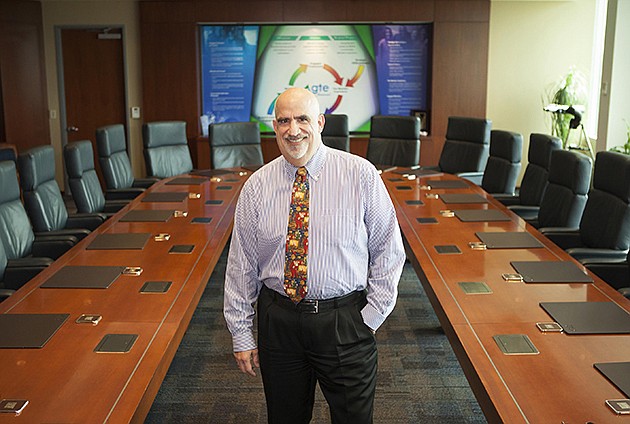Executive Summary
Company. GTE Financial Industry. Credit Unions, finances Key. Credit union is working on transforming its business model to become more tech-savvy.
Joe Brancucci, president and CEO of GTE Financial in Tampa, thinks back to the process-driven financial industry of 45 years ago.
That's well before Internet banking existed. It was a time when transactions with a financial institution could only be made in person, inside the facility. Fast-forward to today, he says, and the industry hasn't really changed too much, despite many attempts to move into a tech-driven world.
At GTE Financial, a credit union with about 240,000 members and $1.7 billion in assets, Brancucci is tired of waiting. His plan is to spark a change and make a complete shift to a technology-focused business plan. Now.
By the end of summer 2016, the credit union, founded in 1935, plans to be entirely tech-based, incorporating features such as online banking, video tellers and iPads for employees.
The catch, according to Brancucci, is that GTE isn't really giving its members a choice. Brancucci calls the transformation a process of disruptive implementation because “if our members don't have to change, they won't.”
Make the change
The shift for GTE will benefit both consumers and employees of the credit union.
One marquee change was the addition of iPads for employees, which are being used to replace the “very paper intensive” paper packets used by GTE during board meetings, Brancucci says. iPads allow employees to simplify the process by maintaining one copy electronically.
That type of simplification can be passed on to consumers, too, if GTE can find an answer to the one integral question: How do you maintain personal relationships through technology?
Constant education is one key focal point there, Brancucci says. He points to a discrepancy between consumers and workers never seen before: Right now, there are five generations of consumers and four generations of workers.
Getting millennials on board with its technology push isn't the hurdle for GTE. Surprisingly to Brancucci, neither is gaining approval from many elderly members, which he says “high five the machines” after a video interaction. Those machines, which GTE calls GTE OnScreen, are basically the combination of an ATM with a bank teller window. It's a personal interaction with a teller through video.
Millennials already seem to be picking up on the new approach. GTE has added about 135,000 members in the past four years. The average age of those new clients is 32, bringing the overall average member age at the credit union down to 44. Brancucci would like to see that average age fall to 42.
With GTE OnScreen and other features like online banking, the credit union is already well on its way to becoming a technology-driven business. Baby boomers, however, are seemingly settled into their routines and resistant to change. But Brancucci, 64, points to his own lifestyle as a reason he thinks they will appreciate the disruptive change for which GTE is shooting.
“I don't have a lot of time,” he says. “If I can do everything online, I do it. There's no value in driving somewhere to do it.”
The biggest challenge credit unions face in becoming reliant on technology is a lack of intimacy, Brancucci says. In what he calls a “people institution,” maintaining relationships with members is always the top priority. And constantly seeking feedback from members is how credit unions stay afloat.
Tampa-based Suncoast Credit Union, a $6.6 billion-based institution, implemented an online health insurance portal earlier this year, for example. The portal, basically a one-stop shop for all types of insurance, came as a direct result of member requests in Suncoast's annual survey.
“This was purely about adding convenience and minimizing uncertainty and helping our members save money,” says Melva McKay-Bass, senior vice president of business development at Suncoast.
While adding a similar portal is not a move GTE plans to make, credit union officials understand Suncoast's approach. “Most credit unions are always looking for ways to enhance the experience of their members and add value,” says Chip Coberly, vice president of member sales for GTE, in a previous interview about Suncoast's portal. “The trend right now is toward self-service and technology.”
Going virtual gives more value to members, Brancucci says. He says members can create an Avatar and virtually interact with credit union employees from home.
Brancucci realizes it takes time for any trend to catch on, but he's confident in the end result. It's like the airline industry, he says. Boarding passes have changed from being hand-written to being printed to being on smart phones, he says. “People didn't stop flying.”
Going to an all-technology model is important, especially to cut costs, but it's not the only way to run a credit union, says Sherod Halliburton, president of Bradenton-based Manatee Community Federal Credit Union, with $30 million in assets.
“Going in that direction tends to push credit unions away from what makes us unique,” he says. “Banks are profit-driven. Credit unions are service-driven.”
Technology might lead the way at GTE, but the focus remains members and helping them achieve big picture goals.
“If a member needs a loan for a car, it's not an auto loan; it's us helping them get a car so they can get to work,” Brancucci says. “If a member needs a loan for a house, it's not a mortgage loan, it's us helping them find a place to live with their family.”
Brancucci also likens GTE's approach to moving a camera around to get a variety of pictures during a photo shoot.
“In business, we tend not to move the lens,” Brancucci says. “We're going to move it.”






